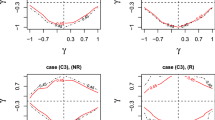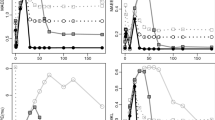Abstract
Least-squares estimation of the lag coefficients of a distributed lag model is not a straightforward regression problem when the sample has missed or distorted observations. Even though the normal equations can be computed using sums of the available cross products, the asymptotic properties of a solution of these equations are unknown. Since a special computer program is required to compute these normal equations when observations are missed, it is practical to consider another approach to the problem.
Paper prepared for the Office of Naval Research Symposium on Time Series Analysis of Irregularly Observed Data, Texas A&M University.
Access this chapter
Tax calculation will be finalised at checkout
Purchases are for personal use only
Preview
Unable to display preview. Download preview PDF.
Similar content being viewed by others
References
Bloomfield, P. (1970). “Spectral Analysis with Randomly Missing Observations,” Journal of the Royal Statistical Society, Series B, 32, 369–380.
Brillinger, D. (1975). Time Series: Data Analysis and Theory, New York: Holt, Rinehart and Winston.
Fuller, W.A. (1976). Introduction to Statistical Time Series, New York: John Wiley.
Gold, B. and C.M. Rader (1969). Digital Processing of Signals, New York: McGraw-Hill.
Hinich, M.J. (1982). “Estimating Distributed Lag Coefficients when there are Errors in the Observed Time Series,” ONR Technical Report No. 26.
— and W.E. Weber (1982). “A Method for Estimating Distributed Lags when Observations are Randomly Missing,” ONR Technical Report No. 21.
Parzen, E. (1963). “On Spectral Analysis with Missing Observations and Amplitude Modulation,” Sankhya, Series A, 25, 383–392.
Robinson, E.A. and S. Treitel (1980). Geophysical Signal Analysis, Englewood Cliffs: Prentice-Hall.
Scheinok, P.A. (1965). “Spectral Analysis with Randomly Missing Observations: The Binomial Case,” Annals of Mathematical Statistics, 36, 971–977.
Author information
Authors and Affiliations
Editor information
Editors and Affiliations
Rights and permissions
Copyright information
© 1984 Springer-Verlag Berlin Heidelberg
About this paper
Cite this paper
Hinich, M.J., Weber, W.E. (1984). A Hilbert Transform Method for Estimating Distributed Lag Models With Randomly Missed or Distorted Observations. In: Parzen, E. (eds) Time Series Analysis of Irregularly Observed Data. Lecture Notes in Statistics, vol 25. Springer, New York, NY. https://doi.org/10.1007/978-1-4684-9403-7_7
Download citation
DOI: https://doi.org/10.1007/978-1-4684-9403-7_7
Publisher Name: Springer, New York, NY
Print ISBN: 978-0-387-96040-1
Online ISBN: 978-1-4684-9403-7
eBook Packages: Springer Book Archive




